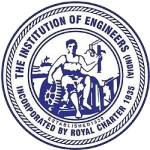Design analysis of electric two wheeler frame
Abstract
The motorcycle frame is one of the major component. It provides vehicle rigidity and strength when the two wheeler is in motion with any road condition. It links various parts of the vehicle system and holds them together. The present study includes modelling of the frame as per structural and ergonomics considerations. The design constraints are governed by loads acting on the frame through front and rear suspension, steering, transmission system and assembly sub systems. The study includes the stress analysis of the designed frame using finite element analysis software (Autodesk fusion 360) for reduced weight without affecting structural strength. Results indicate that a reduction of 20kg (33% weight) can be achieved for a conventional available frame having 60Kg weight. This overall reduced the cost is achieved by selecting proper material and making changes in design. The designed frame can sustain a load of 300Kg / 2943N with safety factor 15.
Downloads
References
Borse, P. A. and Desale, D. P. S. (2017) ‘Effect of Motor Vehicle Structural Vibration on Human Body – Review’, Iarjset, 4(7), pp. 145–149. doi: 10.17148/iarjset.2017.4725.
. Ch.Neeraja, C.R.Sireesha, D. J. (2012) ‘Structural Analysis of Two Wheeler Suspension Frame’, International Journal of Engineering Research & Technology (IJERT), 1(6), pp. 1–6. Available at: https://www.ijert.org/structural-analysis-of-two-wheeler-suspension-frame.
. Chandra, M. R., Sreenivasulu, S. and Hussain, S. A. (2012) ‘Modeling and Structural analysis of heavy vehicle chassis made of polymeric composite material by three different cross sections’, International Journal of Modern Engineering Research (IJMER) www.ijmer.com, 2(4), pp. 2594–2600. Available at: https://s3.amazonaws.com/academia.edu.documents/56474455/PROPUES_TPM.pdf?response-content-disposition=inline%3B filename%3DDiseno_de_un_plan_de_Mantenimiento_Prod.pdf&X-Amz-Algorithm=AWS4-HMAC-SHA256&X-Amz-Credential=AKIAIWOWYYGZ2Y53UL3A%2F20200314%2Fus-e.
. Li-rui, W. and Xiao-long, Y. (2012) ‘Simulation and Improvement of Vehicle Frame Using FEM’, (MEMS), pp. 627–629. doi: 10.2991/mems.2012.20.
. Paningipalli, P. S. and Sayyad, F. B. (2015) ‘Theoretical And Experimental Validation Of Bike Chassis For Weight Reduction’, International Journal of Scientific & Technology Research, 4(8), pp. 4–11.
. Publications, N. et al. (2016) ‘a Review of Vibration Analysis of Scooter’, 3, pp. 1–5.
. Rajappan, R. and Vivekanandhan, M. (2013) ‘Static and modal analysis of chassis by using FEA’, International Journal of Computational Engineering Research, 3(4), pp. 63–73.
. Wu, Chih-fu et al. (no date) ‘A Study on Computer Aided Optimization Design for the Frame Form Generation of Electric Bicycle’, pp. 1–6.
Copyright (c) 2021 Devendra Vashist, Nikhil Singh, Gaurang Tomar, Aayush Shadija Shadija

This work is licensed under a Creative Commons Attribution 4.0 International License.
I/We agree with the provision of the Bye-Law 118 of The Institution of Engineers (India) which states that copyright of each paper published in Institution Journal or Annual Technical Volume in full or in Abstract at its centres shall lie with the Institution.

